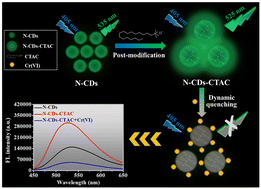Surfactant encapsulating N-doped carbon dots with enhanced optical properties as a selective sensor for Cr(vi) detection†
Abstract
Detecting hexavalent chromium (Cr(VI)) is important for human health and environmental protection due to its high toxicity, carcinogenicity and persistence, but developing a sensor to selectively detect Cr(VI) remains challenging. Here, we proposed a selective fluorescent sensor for Cr(VI) detection using cetyltrimethylammonium chloride (CTAC) modified N-doped carbon dots (N-CDs–CTAC) synthesized via a post-modification strategy. Specifically, the introduced CTAC molecules could self-assemble into micelles for encapsulating fluorescent N-CDs, causing the aggregation of N-CD particles and then displaying enhanced fluorescence emission owing to the aggregation-induced emission effect. Moreover, the positively charged CTAC can interact with negatively charged Cr(VI) in the form of an anion (Cr2O72−), boosting the ability of the selective recognition of Cr(VI). Thus, a N-CDs–CTAC fluorescent probe was designed to selectively monitor Cr(VI) with an ultralow detection limit down to 40 nM, and was further used for Cr(VI) detection in real environmental samples. The fluorescence quenching mechanism of N-CDs–CTAC by Cr(VI) was attributed to dynamic quenching. The proposed assay opens an avenue for the selective detection of Cr(VI) in the environmental monitoring field.



 Please wait while we load your content...
Please wait while we load your content...